Study on the Mechanism of Cumulative Deformation and Method for Suppression in Aircraft Panel Riveting
Abstract
1. Introduction
2. Finite Element Modeling
3. Cumulative Accumulation of Multiple Rivets
3.1. Investigation of the Cumulative Deformation Rules of Specimen 1 during Sequential Riveting
3.1.1. Radial Residual Stress Distribution
3.1.2. Accumulation of and Change in Deformation
3.2. Investigation of the Cumulative Deformation Pattern of Specimen 1 under Changing Order Riveting
3.3. Deformation Accumulation Rule under Sequential Riveting of Specimen 2
4. The Deformation Active Suppression Method
4.1. Discussion on the Deformation Accumulation Mechanism
4.2. The Pre-Bending Active Suppression Method
4.3. Results Analysis of Pre-Bending Deformation Suppression Experiment
5. Conclusions
Author Contributions
Funding
Data Availability Statement
Conflicts of Interest
References
- Zhang, M.H.; Cao, Z.Q.; Zheng, G.; Zuo, D.Q.; Guo, C.X.; Wang, Y.H.X. Quasi-static tensile failure mechanism analysis of CFRP/Al countersunk electromagnetic riveted joints with different rivet-hole clearances. Eng. Fail. Anal. 2024, 155, 107759. [Google Scholar] [CrossRef]
- Li, M.; Tian, W.; Hu, J.S.; Wang, C.R.; Shi, Z.H.; Liao, W.H. Influence of riveting die configuration and squeeze force on the mechanical properties and fatigue behavior of aircraft lap joints. Eng. Fail. Anal. 2022, 142, 10677. [Google Scholar] [CrossRef]
- Zhang, Y.; Lei, B.; Wang, T.; Zhu, L.W.; Lu, Y.; Jiang, J.C. Fatigue failure mechanism and estimation of aluminum alloy self-piercing riveting at different load levels. Eng. Fract. Mech. 2023, 291, 109583. [Google Scholar] [CrossRef]
- Skorupa, A.; Skorupa, M.; Machniewicz, T.; Korbel, A. Fatigue crack location and fatigue life for riveted lap joints in aircraft fuselage. Int. J. Fatigue 2014, 58, 209–217. [Google Scholar] [CrossRef]
- Lv, G.C.; Li, C.Y.; Zhao, C.Y.; Jia, D.W.; Zhang, X.L.; Zhang, H.Z.; Huang, W.C. Research on theoretical prediction method of rivet-forming quality considering different riveted structure parameters. Int. J. Adv. Manuf. Technol. 2024, 132, 2333–2345. [Google Scholar] [CrossRef]
- Jia, D.L.; Zhang, Q.H.; Xiong, L.B.; Li, J.; Bu, Y.Z.; Bao, Y. A unified evaluation method for fatigue resistance of riveted joints based on structural stress approach. Int. J. Fatigue 2022, 160, 106871. [Google Scholar] [CrossRef]
- Di Cicco, F.; Fanelli, P.; Vivio, F. Fatigue reliability evaluation of riveted lap joints using a new rivet element and DFR. Int. J. Fatigue 2017, 101, 430–438. [Google Scholar] [CrossRef]
- Liang, Q.X.; Zhang, T.P.; Zhu, C.R.; Bi, Y.B. Effect of riveting angle and direction on fatigue performance of riveted lap joints. Coatings 2021, 11, 236. [Google Scholar] [CrossRef]
- Nejad, R.M.; Berto, F.; Tohidi, M. Fatigue performance prediction of Al-alloy 2024 plates in riveted joint structure. Eng. Fail. Anal. 2021, 126, 105439. [Google Scholar] [CrossRef]
- Zhang, K.F.; Cheng, H.; Li, Y. Riveting process modeling and simulating for deformation analysis of aircraft’s thin-walled sheet-metal parts. Chin. J. Aeronaut. 2011, 24, 369–377. [Google Scholar] [CrossRef]
- Chang, Z.P.; Wang, Z.Q.; Xie, L.L.; Kang, Y.G.; Xu, M.H.; Wang, Z.M. Prediction of riveting deformation for thin-walled structures using local-global finite element approach. Int. J. Adv. Manuf. Technol. 2018, 97, 2529–2544. [Google Scholar] [CrossRef]
- Liu, G.; Huan, H.L.; Ke, Y.L. Study on analysis and prediction of riveting assembly variation of aircraft fuselage panel. Int. J. Adv. Manuf. Technol. 2014, 75, 991–1003. [Google Scholar] [CrossRef]
- Wang, H. Riveting sequence study of horizontal stabilizer assembly using finite-element analysis and riveting equivalent unit. J. Aerosp. Eng. 2014, 27, 04014040. [Google Scholar] [CrossRef]
- Kondo, A.; Kasahara, T.; Kanda, A. A simplified finite element model of riveted joints for structural analyses with consideration of nonlinear load-transfer characteristics. Aerospace 2021, 8, 196. [Google Scholar] [CrossRef]
- Ni, J.; Tang, W.C.; Xing, Y.; Ben, K.C.; Li, M. A Local-to-Global Dimensional Error Calculation Framework for the Riveted Assembly Using Finite-Element Analysis. J. Manuf. Sci. Eng. 2016, 138, 031004. [Google Scholar] [CrossRef]
- Siahaan, R. Structural Behaviour and Design of Rivet Fastened Rectangular Hollow Flange Channel Beams. Ph.D. Thesis, Queensland University of Technology, Brisbane City, Australia, 2017. [Google Scholar]
- Yin, J.Q.; Gu, J.Y.; Chen, Y.D.; Zhang, F. Global sensitivity analysis of riveting parameters based on a random sampling-high dimensional model representation. Int. J. Adv. Manuf. Technol. 2021, 113, 465–472. [Google Scholar] [CrossRef]
- Wang, Z.Q.; Chang, Z.P.; Luo, Q.; Hua, S.G.; Zhao, H.T.; Kang, Y.G. Optimization of riveting parameters using Kriging and particle swarm optimization to improve deformation homogeneity in aircraft assembly. Adv. Mech. Eng. 2017, 9, 1687814017719003. [Google Scholar] [CrossRef]
- Yang, D.; Qu, W.-W.; Ke, Y.-L. Evaluation of residual clearance after pre-joining and pre-joining scheme optimization in aircraft panel assembly. Assem. Autom. 2016, 36, 376–387. [Google Scholar] [CrossRef]
- Xu, W.-C.; Wang, D.-F. Fatigue and impact analysis and multi-objective optimization design of Mg/Al assembled wheel considering riveting residual stress. Front. Mech. Eng. 2022, 17, 45. [Google Scholar] [CrossRef]
- Han, Z.-P.; Wang, Y.; Tian, D. Ant colony optimization for assembly sequence planning based on parameters optimization. Front. Mech. Eng. 2021, 16, 393–409. [Google Scholar] [CrossRef]
- Chen, B.J.; Xiao, Z.M.; Liew, K.M. A line dislocation interacting with a semi-infinite crack in piezoelectric solid. Int. J. Eng. Sci. 2004, 42, 1–11. [Google Scholar] [CrossRef]
- Daoud, M.; Chatelain, J.F.; Bouzid, A. Effect of rake angle-based Johnson-Cook material constants on the prediction of residual stresses and temperatures induced in Al2024-T3 machining. Int. J. Mech. Sci. 2017, 122, 392–404. [Google Scholar] [CrossRef]
- Yin, J.Q.; Wang, Z.Q.; Kang, Y.G.; Hu, Y.L. Research on the maximum riveting force based on theory of compression instability. Adv. Mater. Res. 2013, 716, 744–748. [Google Scholar] [CrossRef]
- Chang, Z.Q.; Wang, Z.Q.; Jiang, B.; Zhang, J.M.; Guo, F.Y.; Kang, Y.G. Modeling and predicting of aeronautical thin-walled sheet metal parts riveting deformation. Assem. Autom. 2016, 36, 296–307. [Google Scholar] [CrossRef]

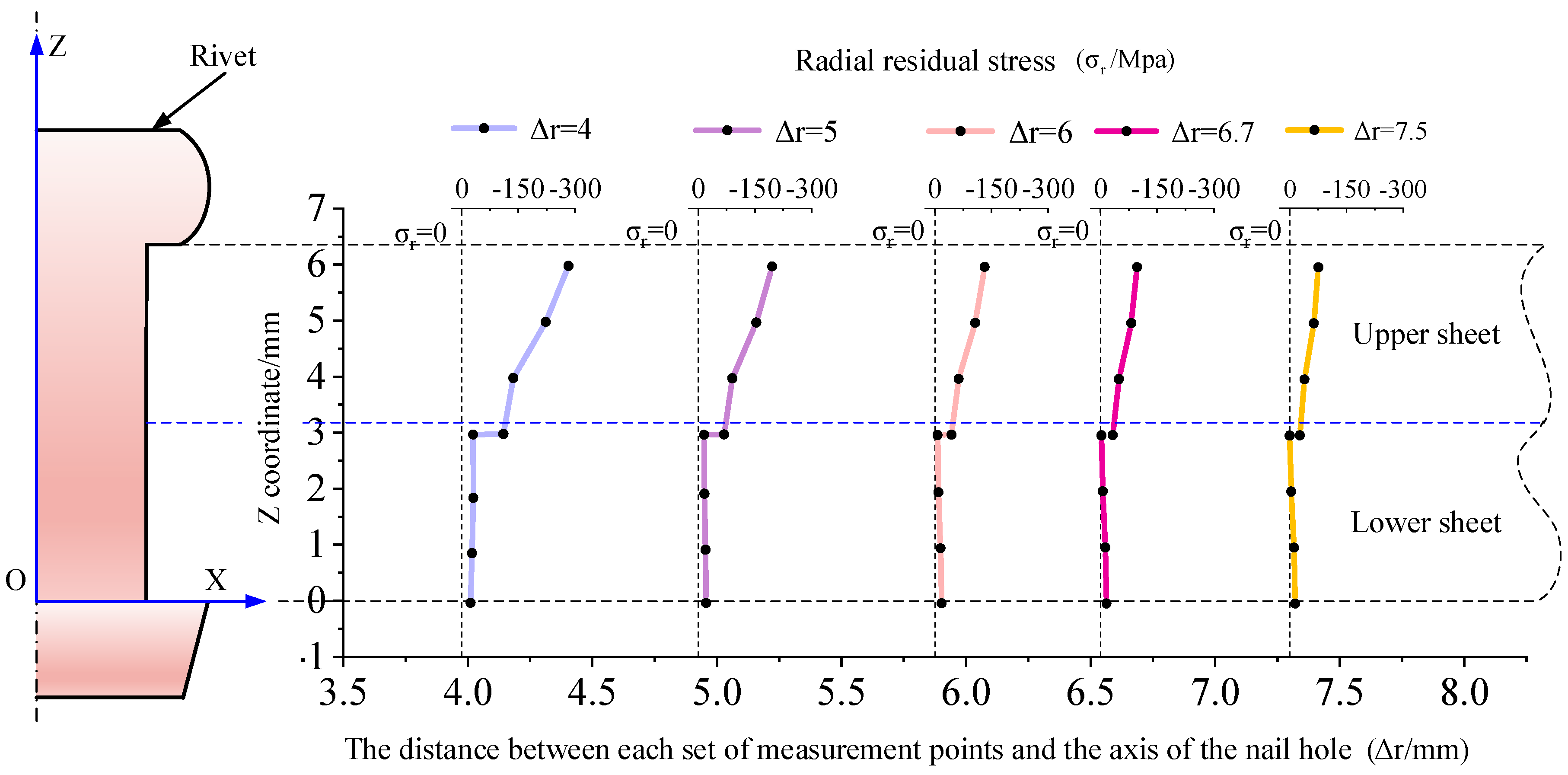


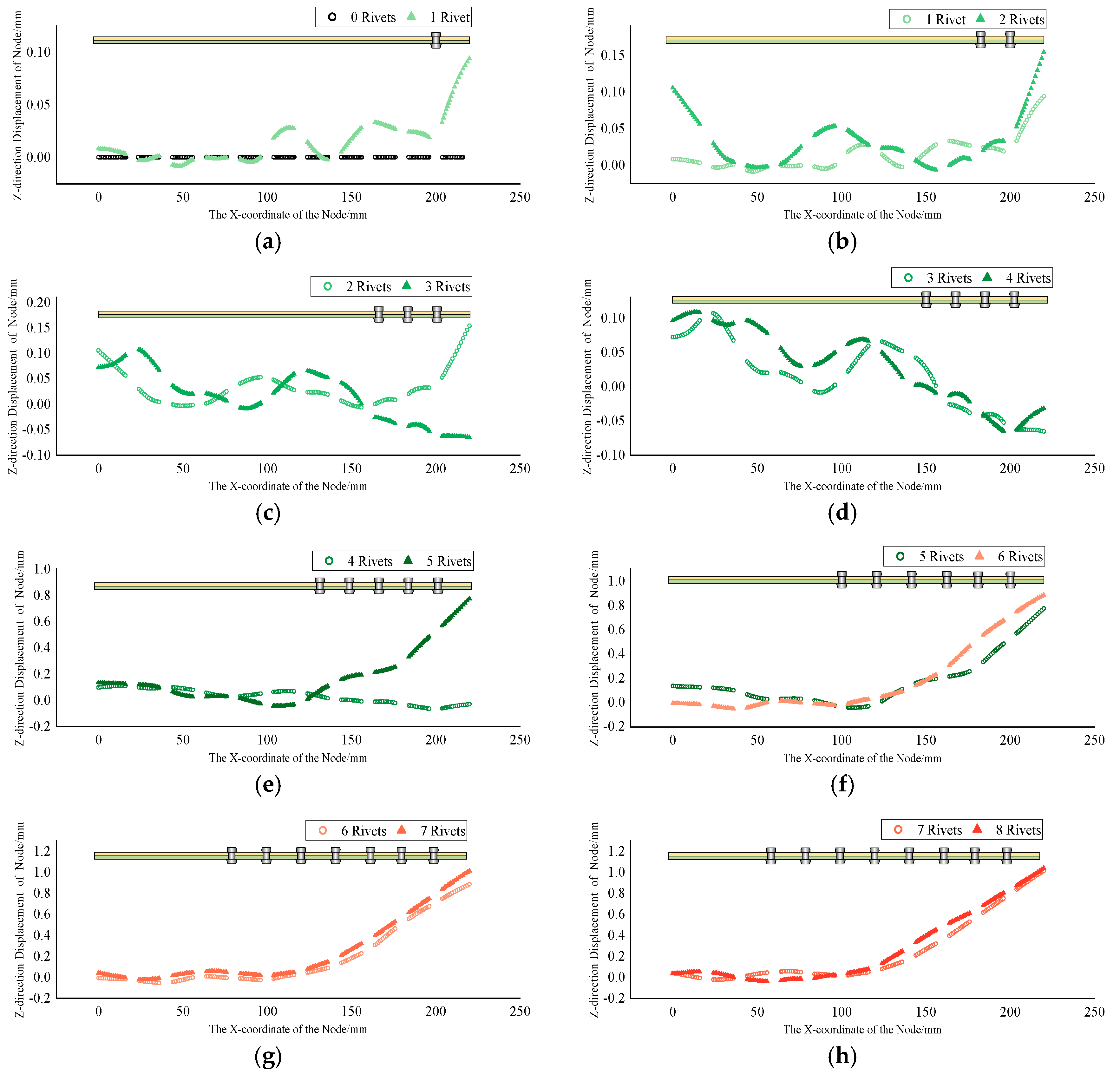

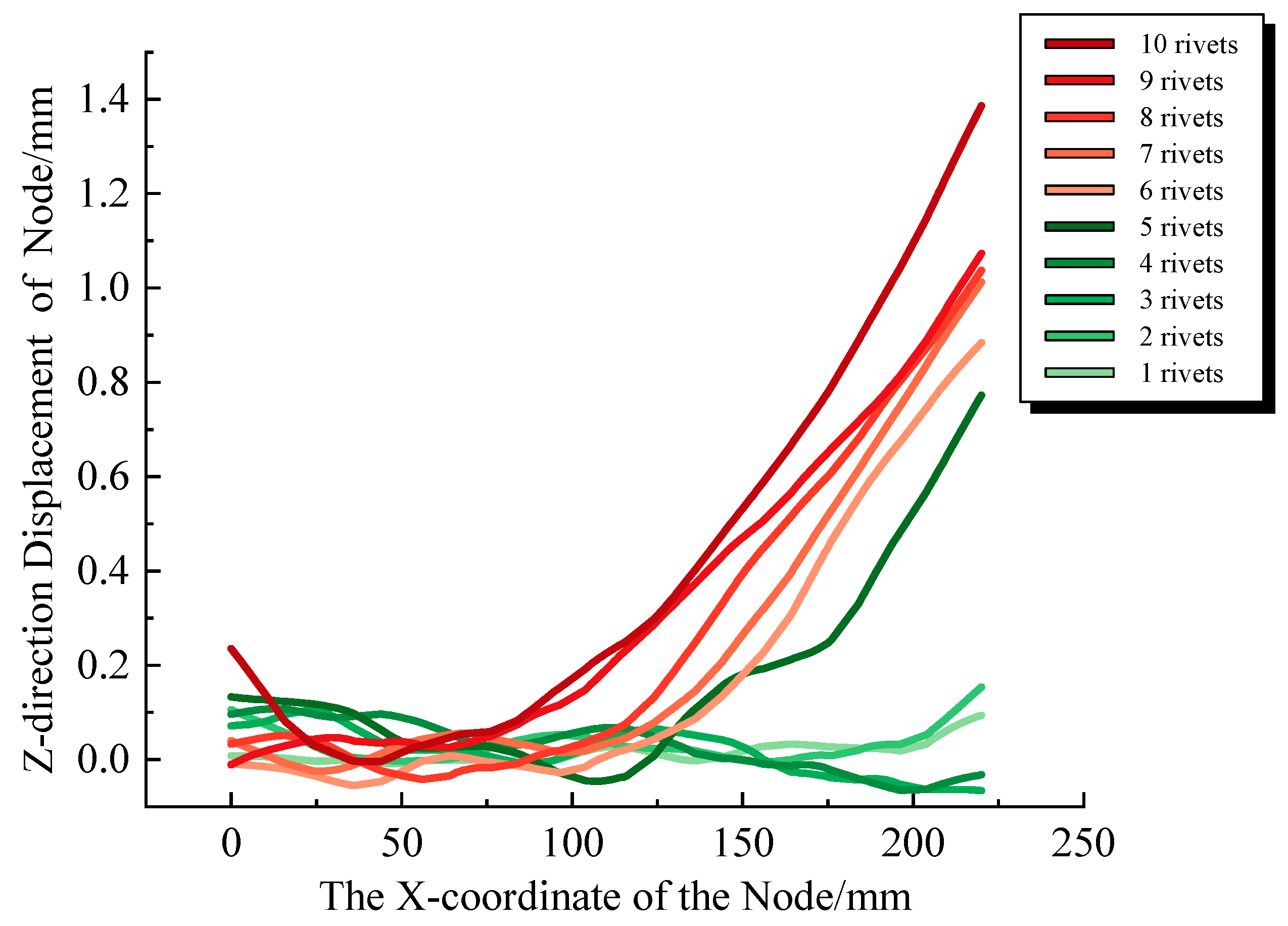
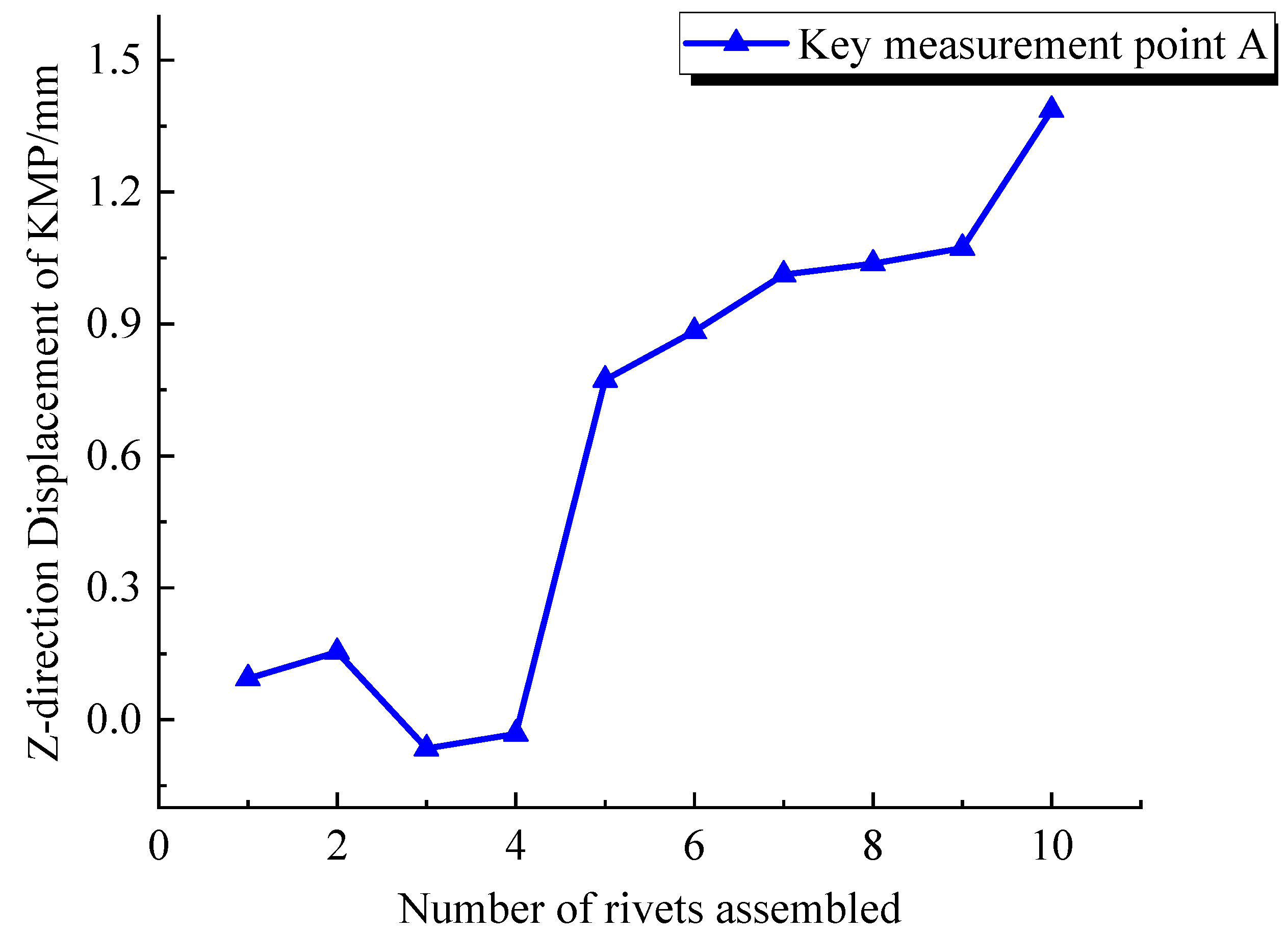


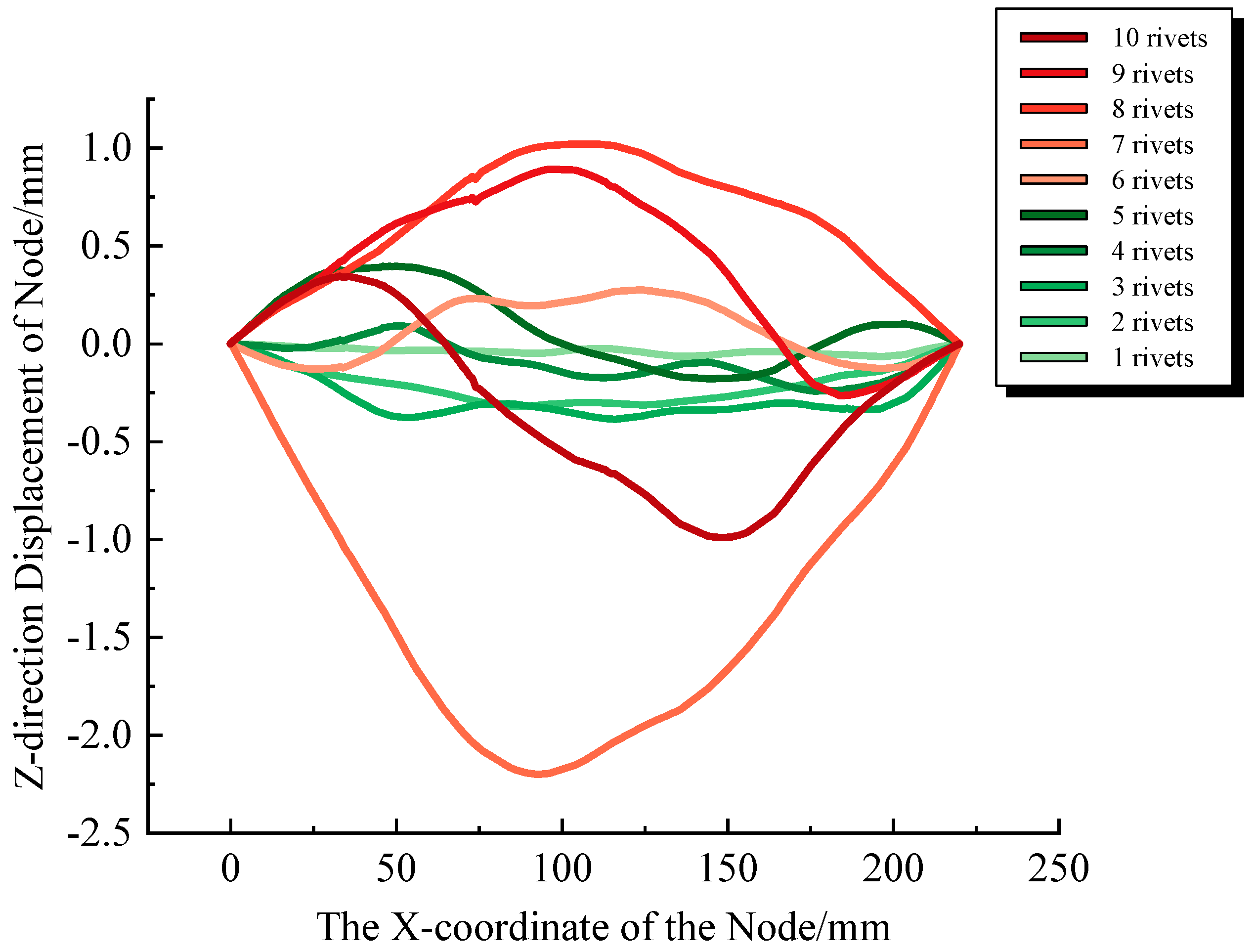
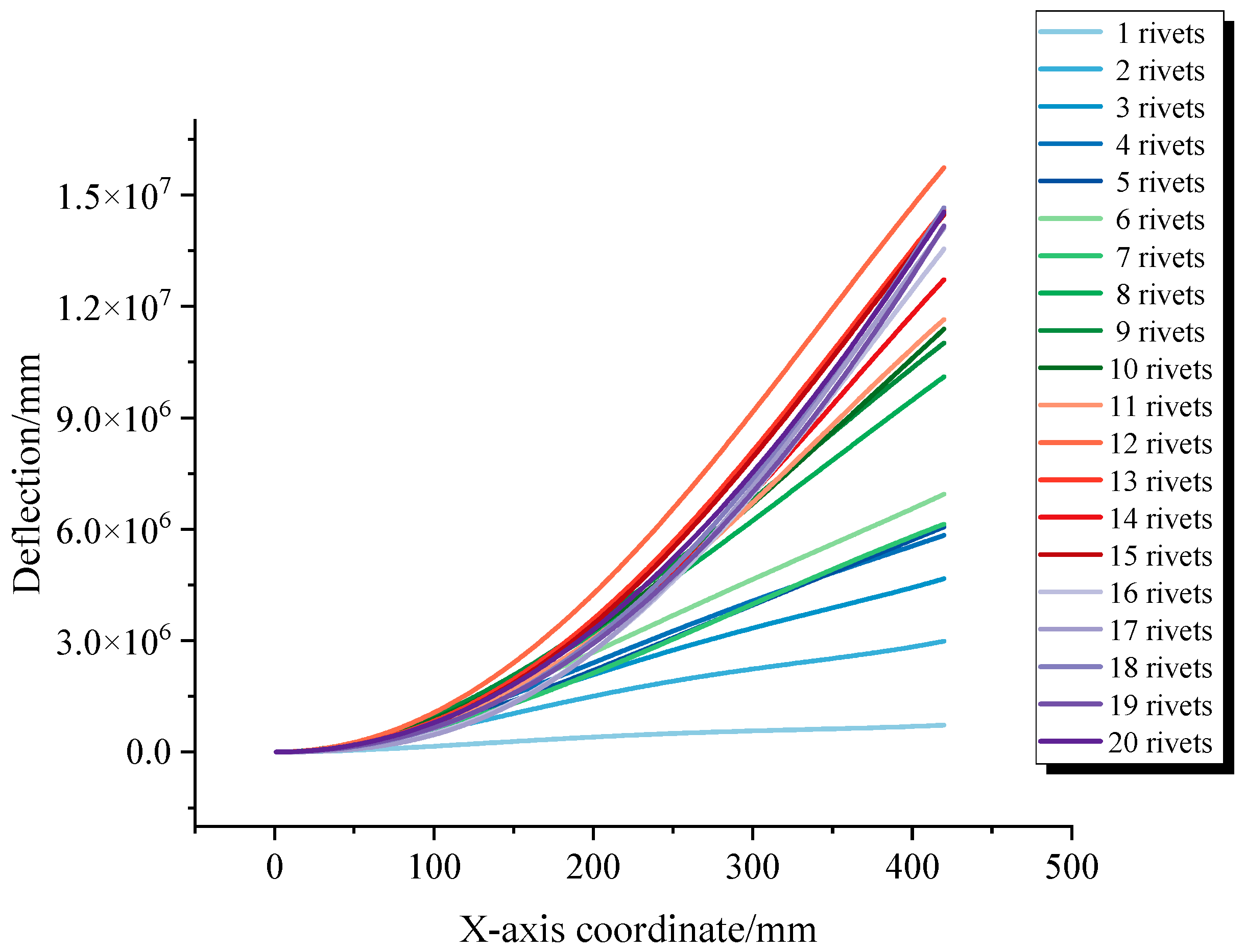

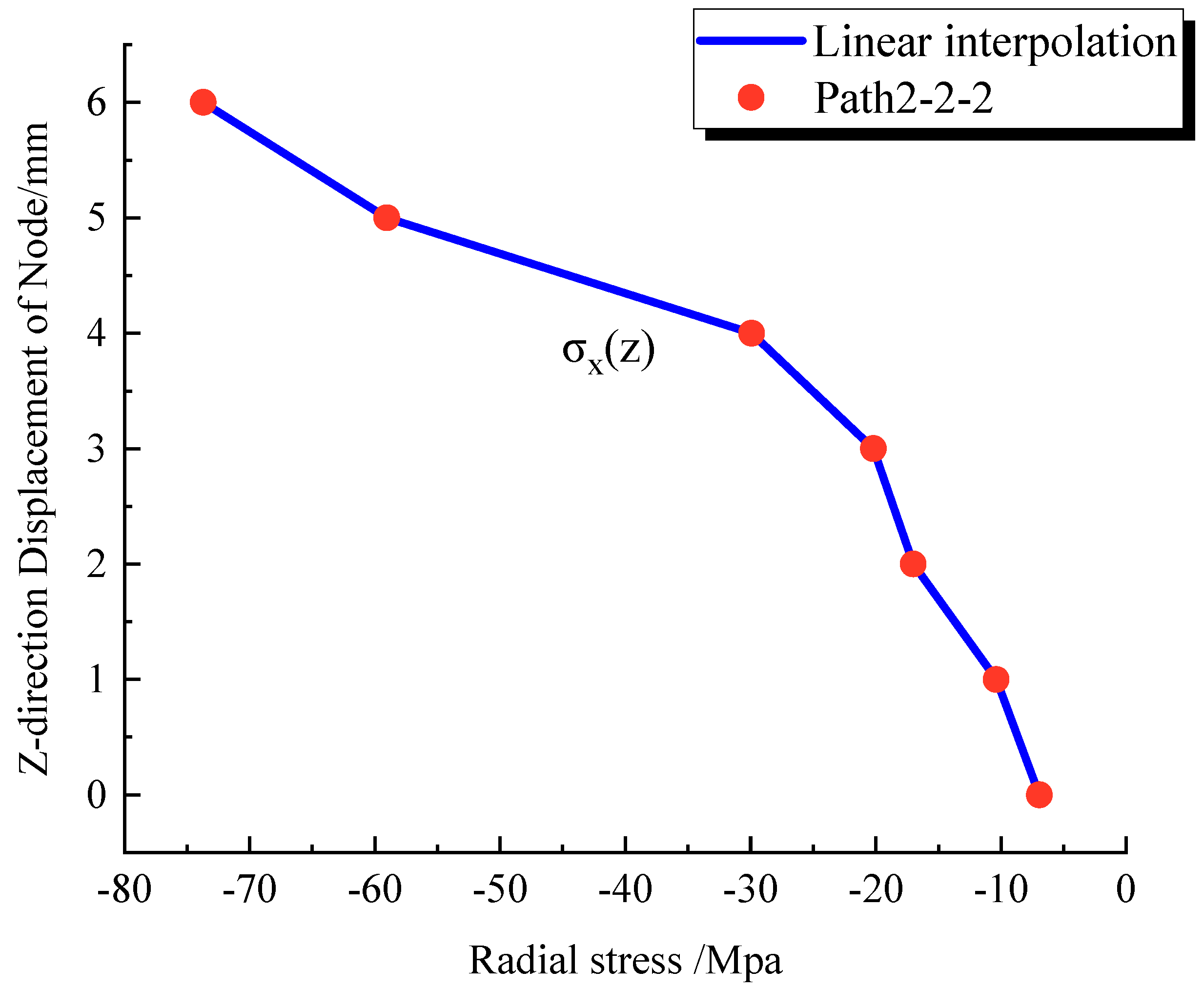

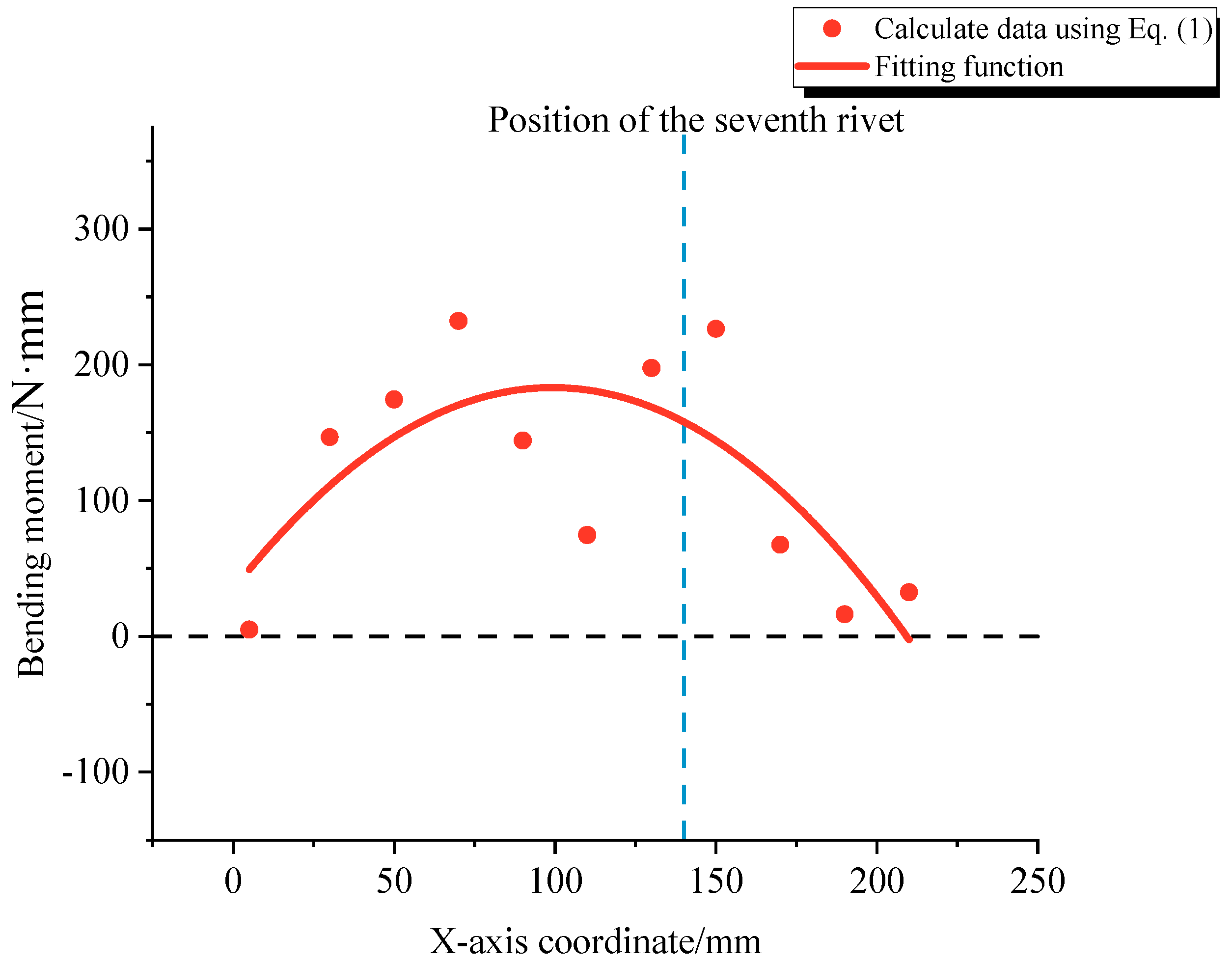
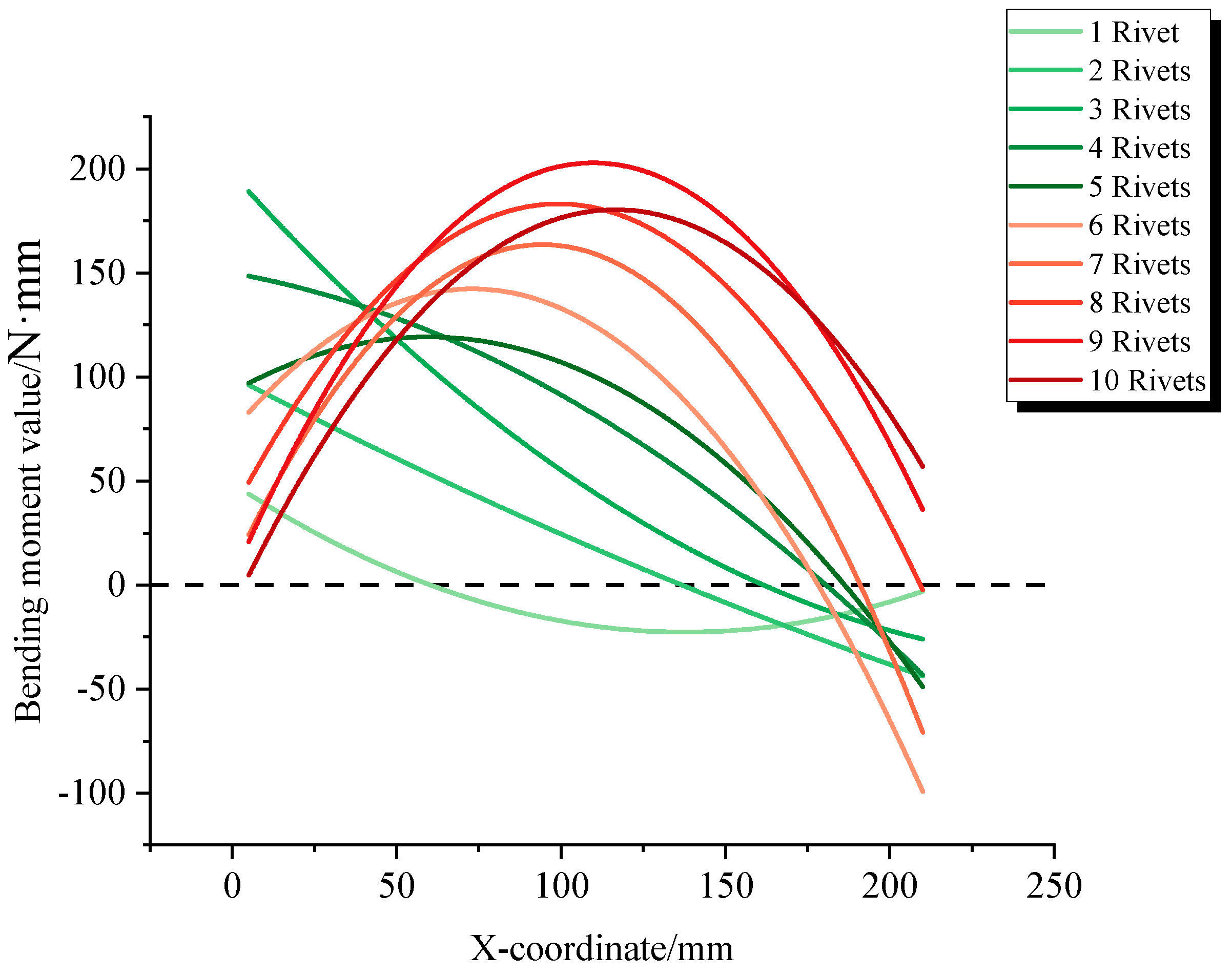
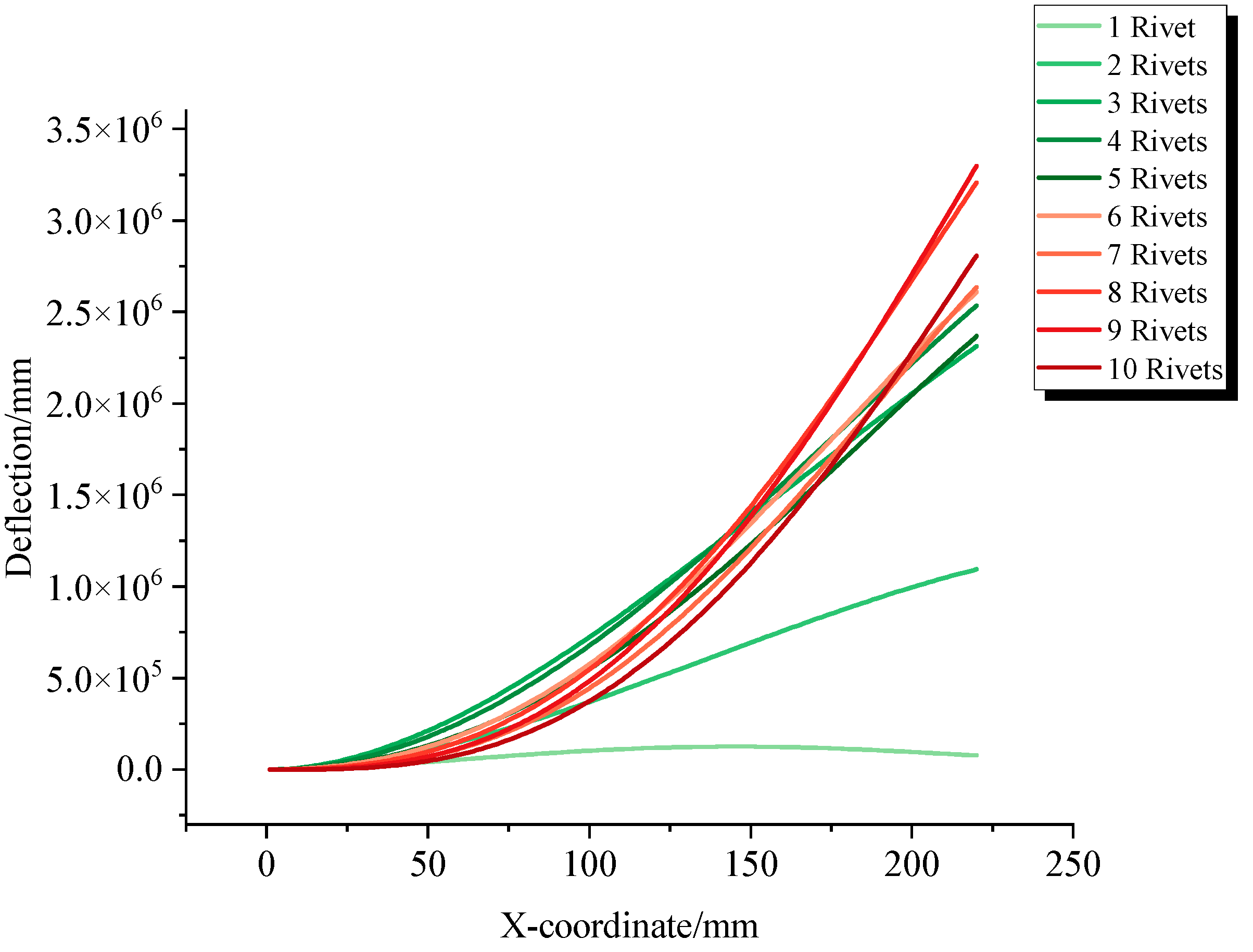
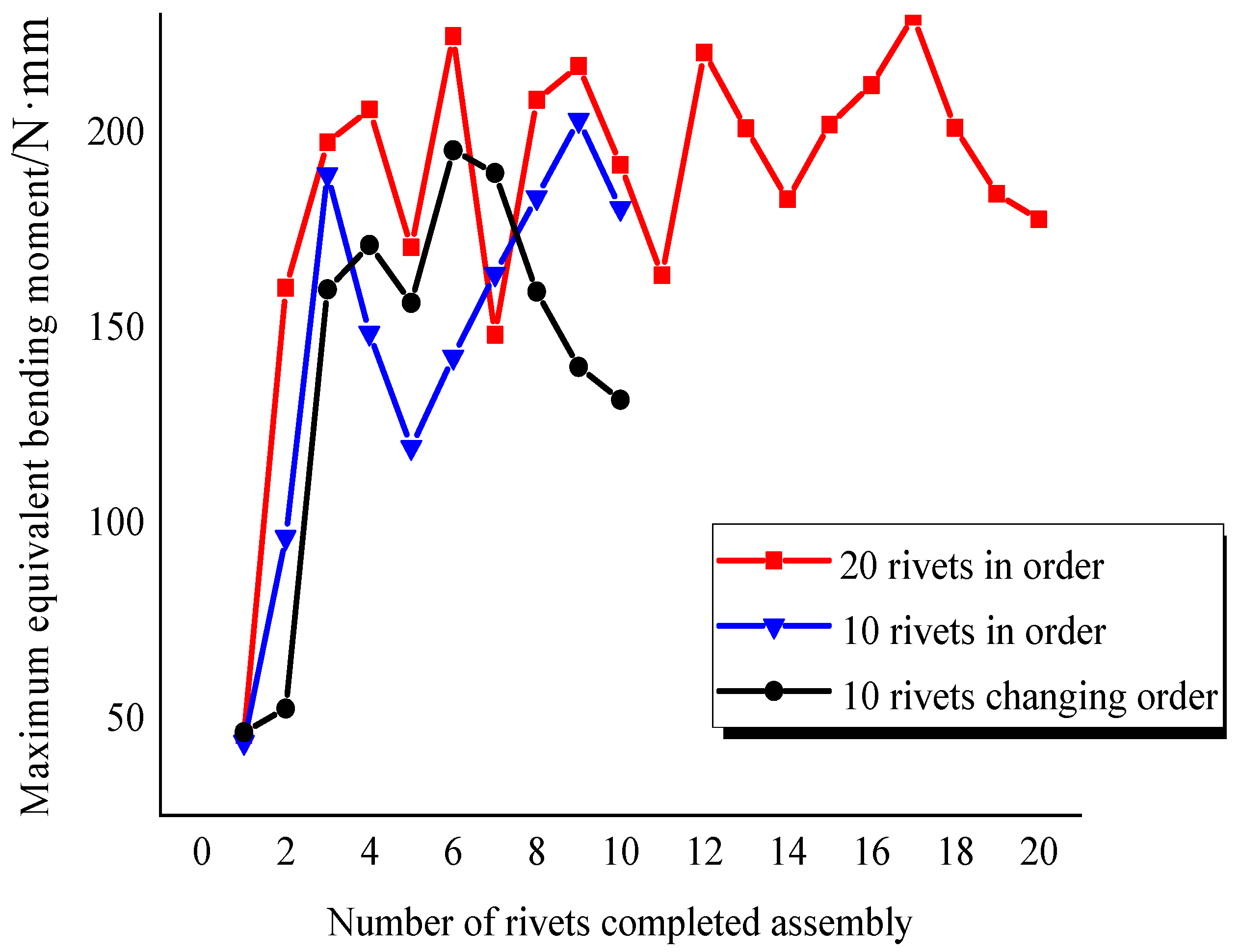
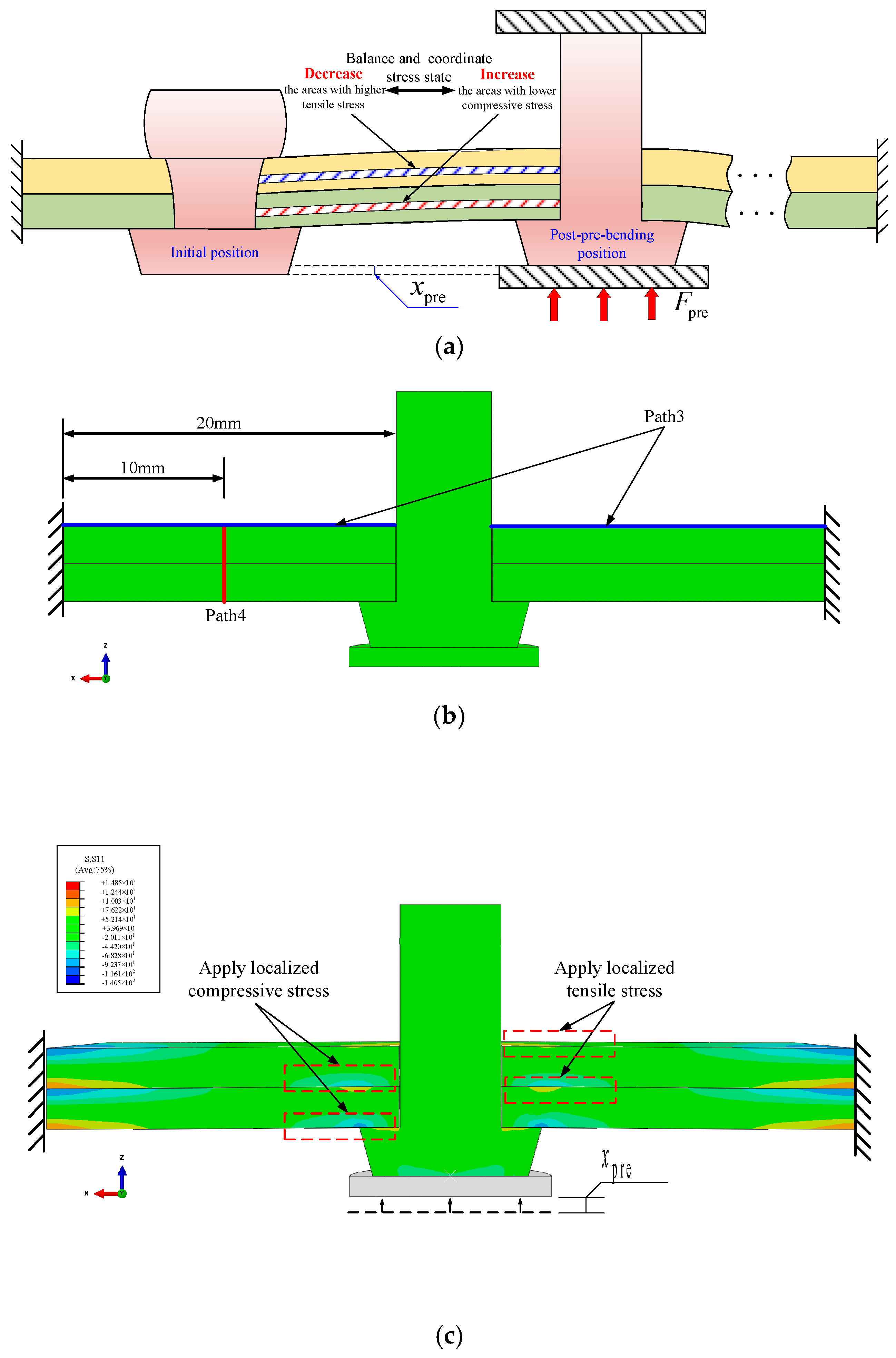

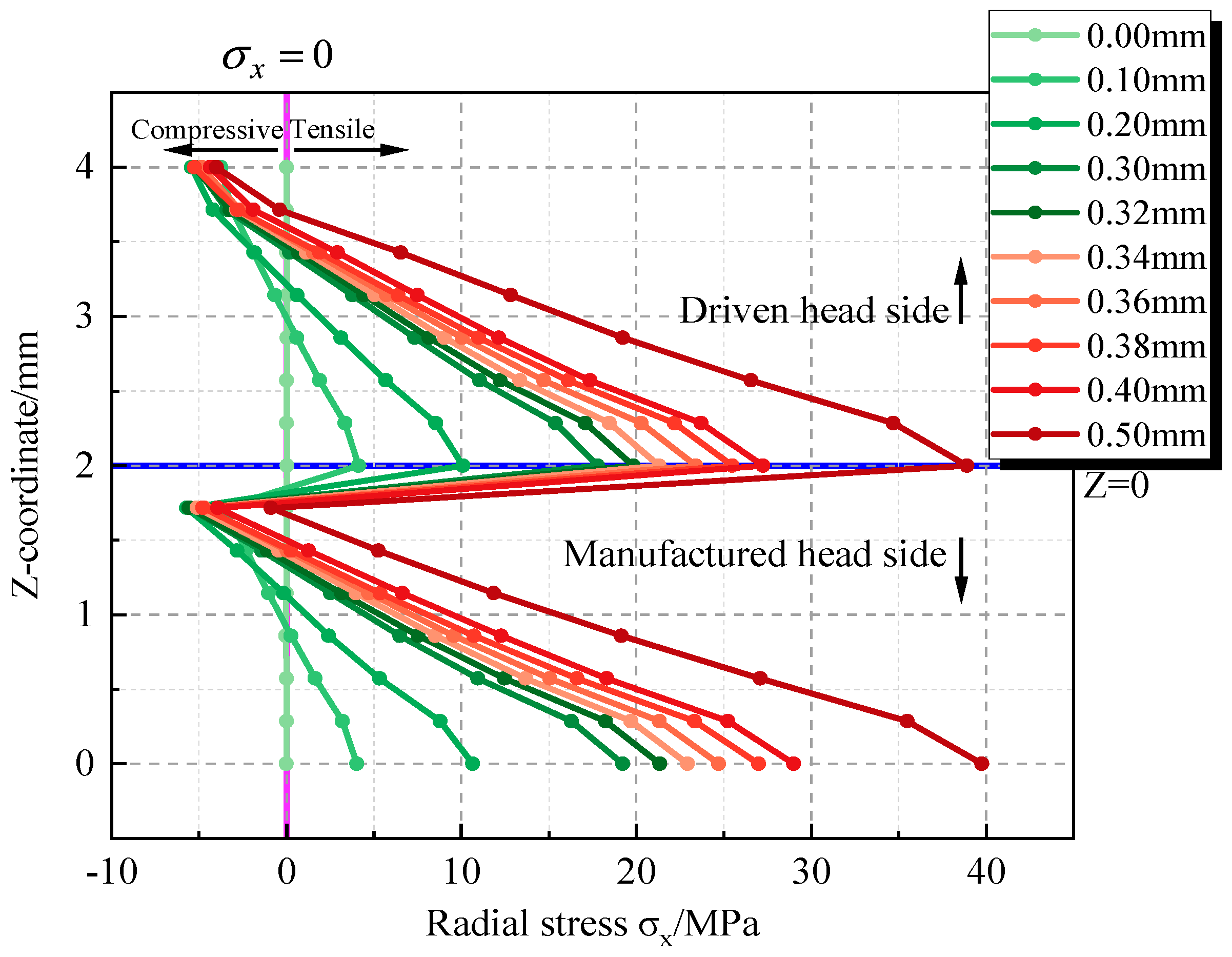
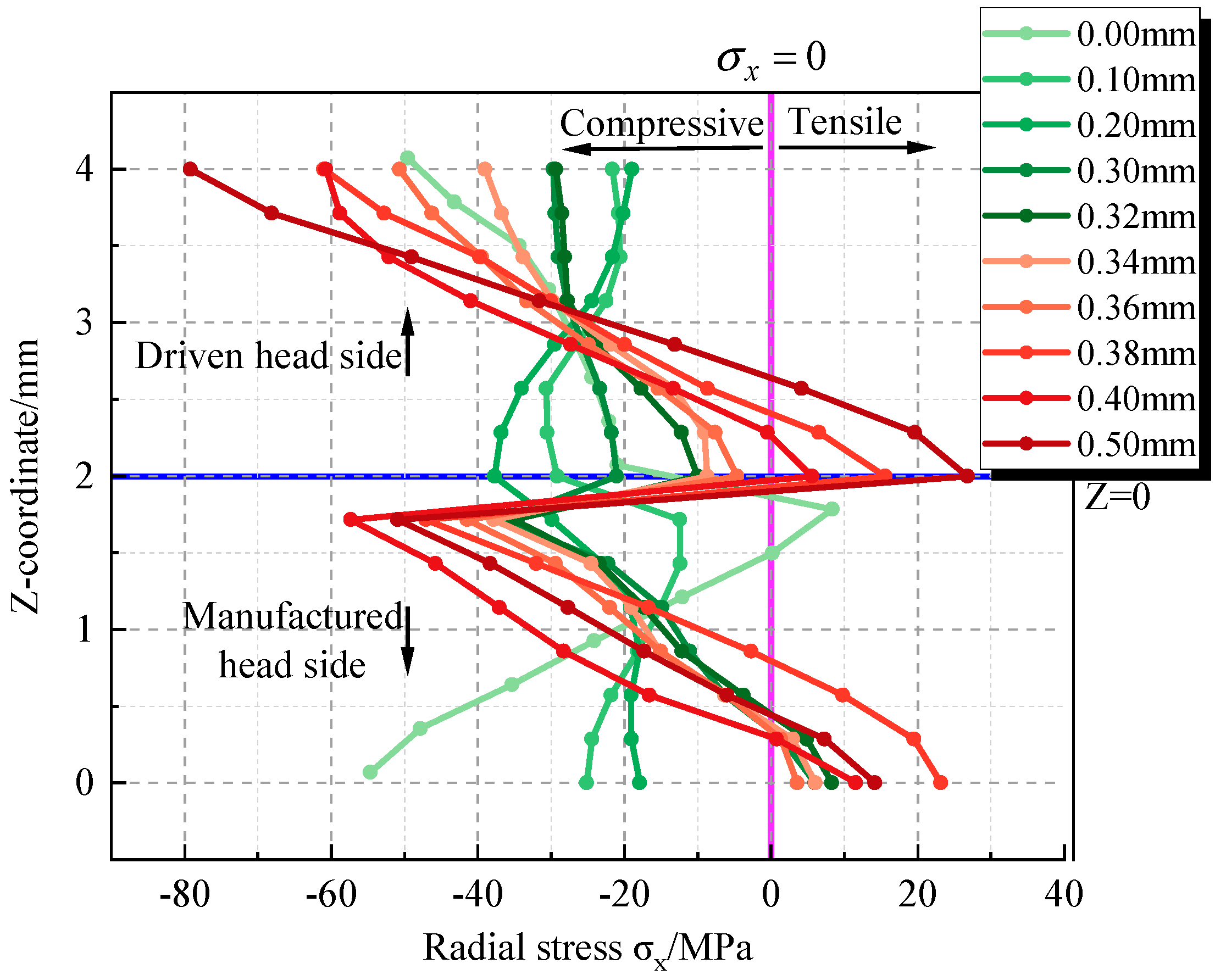
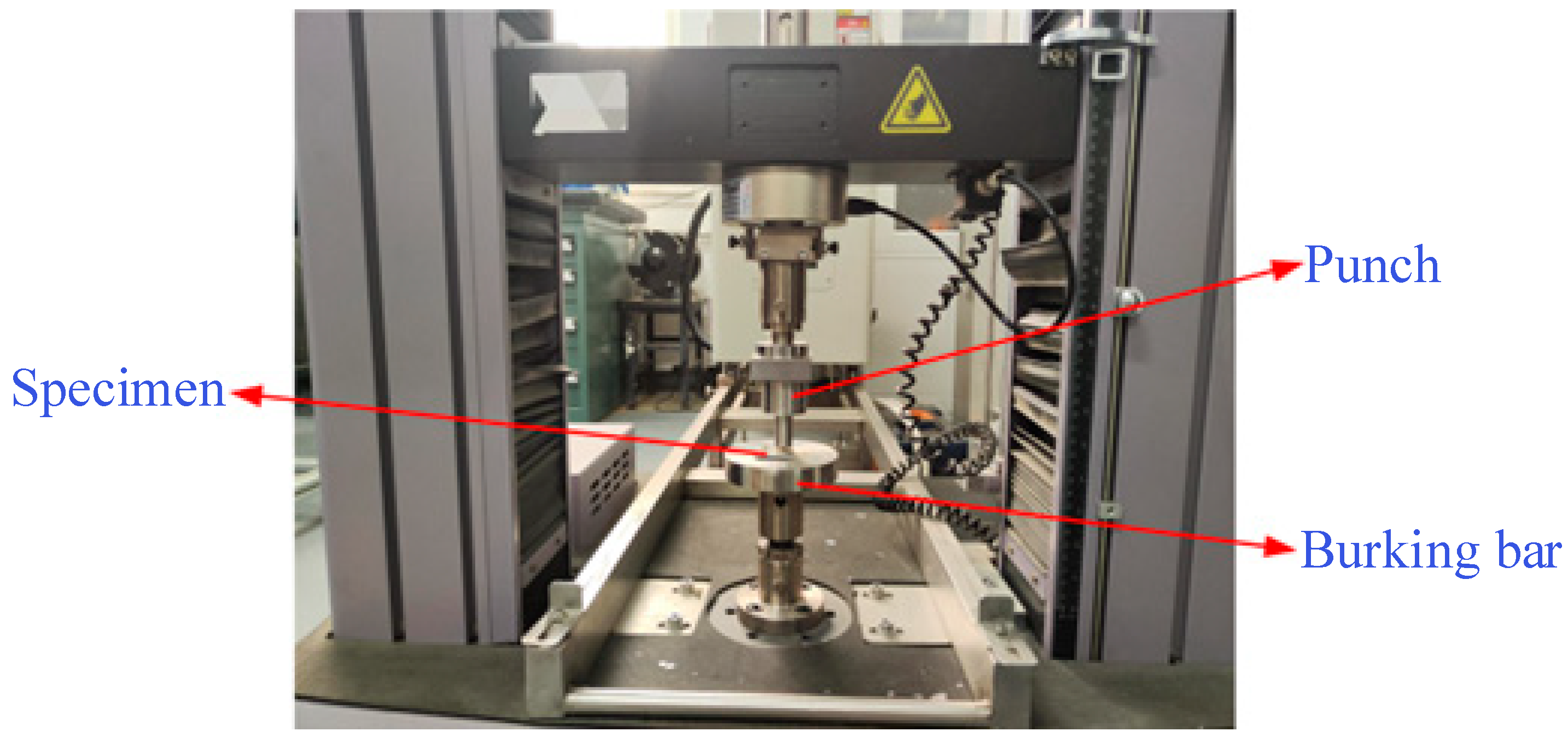
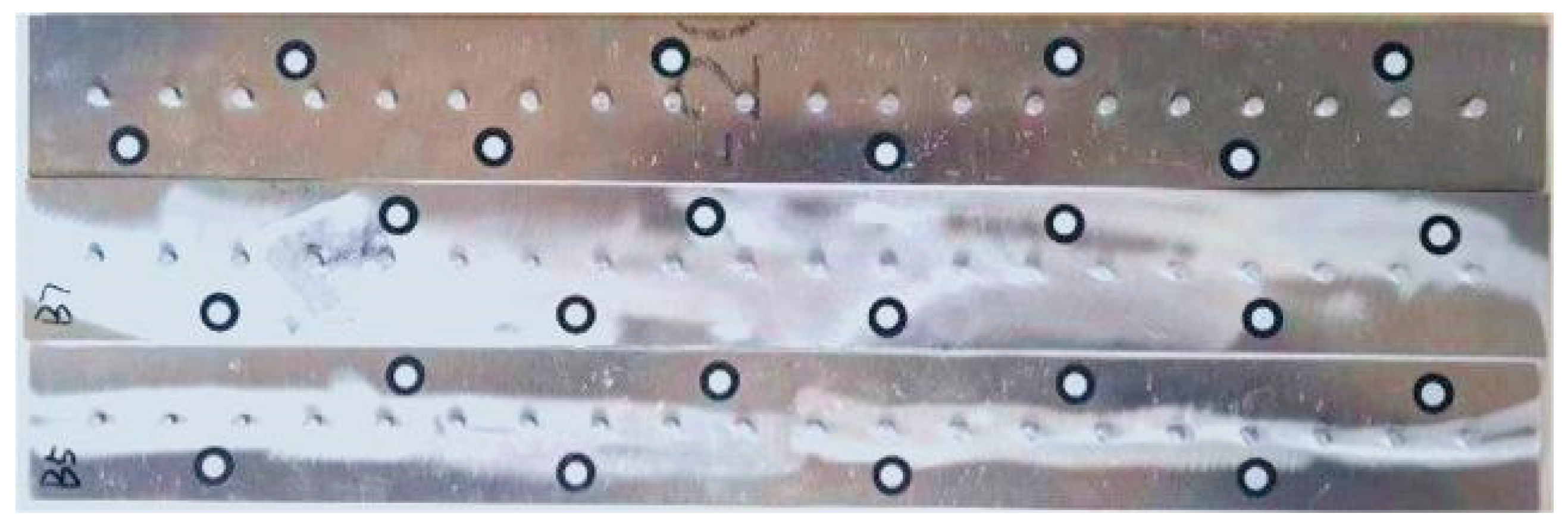
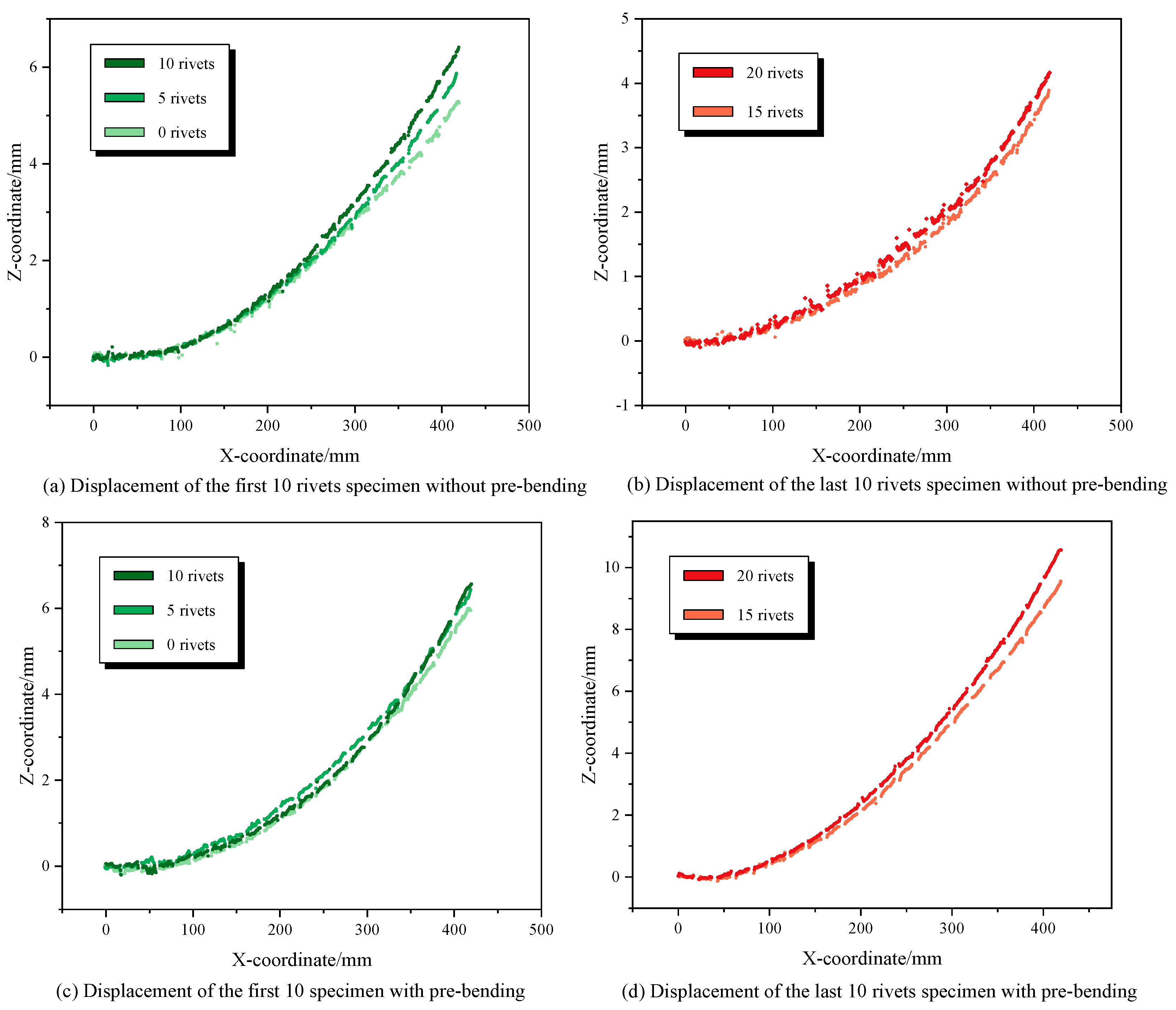
| Parameter | Numeric Value/mm | Parameter | Numeric Value/mm |
|---|---|---|---|
| Length of specimen | 220/420 | The width of the specimen | 45 |
| The specimen thickness | 6 | Nail hole diameter | 4.08 |
| Rivet diameter | 10 | Rivet thickness | 1 |
| Friction coefficient μ | 0.18 | Strength coefficient K of rivet material 2A10 | 555.61 |
| Press the outer diameter of the rim | 13 | Hardening exponent n of rivet material 2A10 | 0.14383 |
| The elastic modulus | 71 Gpa | Yield strength σs of rivet material 2A10 | 243 Mpa |
| Rivet material | 2A10 | Joining sheet material | Al2024-T3 |
| Number | Master Surfaces | Slave Surfaces | Contact Algorithm |
|---|---|---|---|
| 1 | The lower surface of the burking bar | Rivet stem surface | K |
| 2 | The upper surface of the punch | Manufacturing head surface | K |
| 3 | The upper surface of the lower blank holder | Lower surface of the lower sheet | p |
| 4 | The lower surface of the upper blank holder | Upper surface of thet upper sheet | P |
| 5 | The upper surface of the lower sheet | Lower surface of the upper sheet | P |
| 6 | The lower surface of the lower sheet and outer surface of the hole | Rivet outer surface | P |
| 7 | The upper surface of the upper sheet and outer surface of the hole | Rivet outer surface | P |
Disclaimer/Publisher’s Note: The statements, opinions and data contained in all publications are solely those of the individual author(s) and contributor(s) and not of MDPI and/or the editor(s). MDPI and/or the editor(s) disclaim responsibility for any injury to people or property resulting from any ideas, methods, instructions or products referred to in the content. |
© 2024 by the authors. Licensee MDPI, Basel, Switzerland. This article is an open access article distributed under the terms and conditions of the Creative Commons Attribution (CC BY) license (https://creativecommons.org/licenses/by/4.0/).
Share and Cite
Kang, Y.; Song, S.; Wang, T.; Li, G.; Wang, Z.; Chen, Y. Study on the Mechanism of Cumulative Deformation and Method for Suppression in Aircraft Panel Riveting. Aerospace 2024, 11, 678. https://doi.org/10.3390/aerospace11080678
Kang Y, Song S, Wang T, Li G, Wang Z, Chen Y. Study on the Mechanism of Cumulative Deformation and Method for Suppression in Aircraft Panel Riveting. Aerospace. 2024; 11(8):678. https://doi.org/10.3390/aerospace11080678
Chicago/Turabian StyleKang, Yonggang, Siren Song, Tianyu Wang, Guomao Li, Zihao Wang, and Yonggang Chen. 2024. "Study on the Mechanism of Cumulative Deformation and Method for Suppression in Aircraft Panel Riveting" Aerospace 11, no. 8: 678. https://doi.org/10.3390/aerospace11080678
APA StyleKang, Y., Song, S., Wang, T., Li, G., Wang, Z., & Chen, Y. (2024). Study on the Mechanism of Cumulative Deformation and Method for Suppression in Aircraft Panel Riveting. Aerospace, 11(8), 678. https://doi.org/10.3390/aerospace11080678






